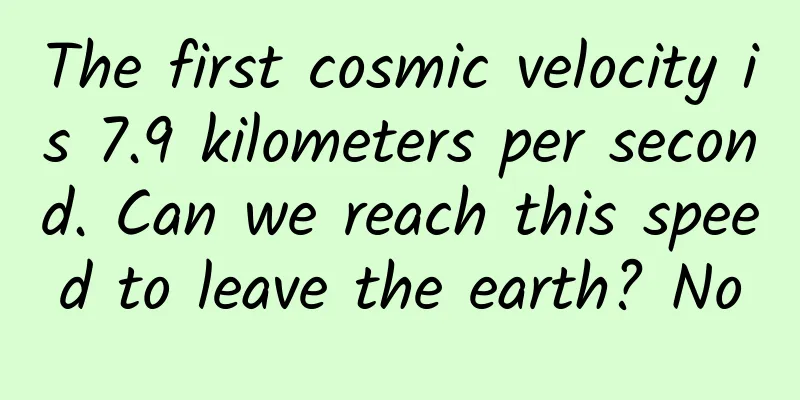The first cosmic velocity is 7.9 kilometers per second. Can we reach this speed to leave the earth? No

|
The first cosmic velocity is 7.9 kilometers per second, and it has another name, which is "orbital velocity." As the name implies, as long as an object has an initial velocity of 7.9 kilometers per second, it can become a satellite of the earth and orbit the earth without falling. But don't think that every artificial earth satellite we launch is launched at this speed. The concept of the first cosmic velocity originated from a hypothesis of Newton, which says that if a cannonball is fired horizontally from the earth and the speed of the cannonball is fast enough, it will orbit the earth and never fall to the ground. This hypothesis is called "Newton's Cannon", and there is an essential difference between a cannonball and a rocket. A cannonball has no subsequent power, so it can only enter the earth's orbit if it has a fast enough initial velocity. Rockets use the reaction force of the backward ejected material to propel them forward, so in theory, if a rocket has a constant supply of power, then no matter how slowly it flies, it will eventually enter Earth orbit. Of course, this is just a theory. In reality, rockets are powered by chemical energy, and fuel accounts for most of the weight of the rocket. Therefore, the speed must be increased as much as possible to send the spacecraft into space. So how is the first cosmic velocity calculated? How fast does the speed of a rocket need to be in reality? When an artificial satellite orbits the earth, it is actually performing a centripetal motion, and the centripetal force that supports this centripetal motion is actually gravity. In this case, we can list the expression of the centripetal force, namely: G=m(V∧2/R). G=M(V∧2/R), where G is the centripetal force, or the gravitational constant, m is the mass of the satellite, and R is the radius of the earth. Compared to the Earth, the mass of an artificial satellite is very small and can be basically ignored, so according to this formula, the speed V can be calculated to be 7.9km/s, which is the first cosmic speed. The first cosmic speed is relative to the center of the Earth, and the Earth itself rotates, so when launching a spacecraft, the Earth's rotation speed can be used, which can save more effort. As a sphere, the Earth has different rotation linear velocities at different locations. The fastest in the equatorial region is about 460m/s, which means that to launch a rocket in the equatorial region, it only needs to reach a speed of 7.4km/s. Because launching a rocket in the equatorial region can maximize the use of force, many countries in the world choose to build launch bases close to the equator, such as my country's Wenchang Launch Base in Hainan. The launch speed of my country's Long March series rockets is around 7.5km/s. If you reach the first cosmic velocity, you can orbit the earth. What if you exceed the first cosmic velocity? If the speed of an object is exactly equal to the first cosmic velocity, then in theory it will orbit the earth in a nearly circular orbit. When the speed of this object exceeds the first cosmic velocity, its orbit will tend to be elliptical, and the faster the speed, the more elliptical the ellipse. If the speed of this object reaches a threshold, then it can completely get rid of the gravitational pull of the earth. This threshold is the second cosmic velocity. Once an object's movement speed reaches the second cosmic velocity, it can escape from the earth, so the second cosmic velocity is also called the "escape velocity." What is the second cosmic velocity? The derivation of the second cosmic velocity is more complicated. We will skip this process and directly give the formula, that is, V=√2GM/R. In this formula, G is still the gravitational constant, M is the mass of the earth, and R is the radius of the earth. After calculation, we can get the result of V=11.2km/s, which is the second cosmic velocity. If an object reaches the first cosmic velocity, it can become a satellite of the earth. If it reaches the second cosmic velocity, it can become a planet orbiting the sun. What if it wants to break out of the solar system? Of course it can, which requires reaching the third cosmic velocity. The derivation process of the third cosmic velocity is more complicated, so we will directly give the formula, which is V=√2V(earth). The 2V (earth) in this formula represents the speed of the Earth's revolution around the Sun, which is about 30 kilometers per second. This formula is calculated with the Sun as the reference system, and the third cosmic speed we are talking about is with the Earth as the reference system, so we must also subtract the Earth's own revolution speed, so the formula becomes V = (√2-1) V (earth), and the result is 16.7 km/s, which is the third cosmic speed. The solar system is just an ordinary star system in the universe, and there are many larger cosmic structures outside it, so there are fourth, fifth, and other cosmic speeds outside the third cosmic speed, but we cannot calculate them with our current capabilities because we cannot determine the mass of larger cosmic structures. For more information, please follow the official account: sunmonarch |
<<: I often feel tired. What’s going on?
>>: Rare! A green sky appeared in this city!
Recommend
How to transform Mars into a second Earth?
Among the planets in the solar system, Mars is th...
During the Qingming outing, you will definitely see them at your feet
The Qingming Festival holiday is here. Originated...
The egg yolk pie, a national snack and even a favorite of internet celebrities, has also collapsed?
Review expert: Wang Guoyi, Postdoctoral Fellow in...
Have you received any orders from Baidu AiPurchasing? Is Baidu Ai Purchasing effective?
Since its launch, Baidu Ai Procurement products h...
What is the most effective way to attract new customers? Take a look at these classic cases!
What is user operation ? User operation is a way ...
WeChat’s paid reading service has not yet arrived, but Douban Time has quietly gone online!
The paid era of the knowledge economy is still ad...
How to plan an event? 6 big steps!
The concept of "organizing an event" ma...
OCPM/OCPC, a detailed explanation of the deep conversion dual bidding capabilities
Regarding OCPX, namely OCPC/ OCPM /OCPA advertisi...
How to set keywords for iOS APP titles and find the right length and keywords
Today’s article is about the length of iOS APP na...
What happens from URL input to page display?
Preface What exactly happens when you open a brow...
With KOLs in the spotlight, how can we efficiently shape our personal IP?
In the past two years, with the development of co...
Learn more about IOS9 every day 2: UI testing
Automated testing of user interface tools is very...
What kind of new world will smart fashion open up?
Now, smart watches dominate the smart wearable de...
The hunting suit market is too competitive. The 2025 Song L EV is fully upgraded with more features but no price increase. It starts at 189,800 yuan.
On August 30, the 2024 Chengdu Auto Show official...









